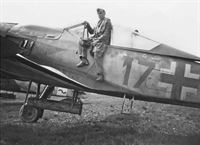Фотографии
-
The damage inflicted on B-17F 42-29997 The Sack of the Eighth Air Force’s 379th Bomb Group, by a W.Gr.21 during a raid on Kassel and Oschersleben on July 28, 1943. The blast from the mortar caused the bomber’s oxygen bottles to explode, but the Fortress managed to return to the UK safely.
Самолёты на фотографии: Boeing B-17E / B-17G Flying Fortress - США - 1941
-
Young Luftwaffe fighter pilots watch and listen carefully as an experienced NCO pilot uses a model of a Messerschmitt Bf 109 to demonstrate tactics to be deployed against an American B-24 bomber in Sicily in 1943. The model is fitted with wire frames to represent the cones of fire from a B-24’s defensive guns.
Самолёты на фотографии: Consolidated B-24 Liberator - США - 1939Messerschmitt Bf.109F - Германия - 1940
-
A pair of Messerschmitt Bf 110G-2s of ZG 76 fitted with twin mortar sets on each wing head off in search of prey.
Самолёты на фотографии: Messerschmitt Bf.110G - Германия - 1941
-
A dramatic photo capturing the moment a mortar is launched from ‘‘White 4” during a static test at Barth in early 1944.
Самолёты на фотографии: Focke-Wulf FW.190A - Германия - 1941
-
Focke-Wulf Fw 190A-5 WNr 1372, ‘‘White 4”, was used extensively for static firing trials, and is seen here with its tail jacked up and a W.Gr.21 mortar attached to the starboard wing.
Самолёты на фотографии: Focke-Wulf FW.190A - Германия - 1941
-
The aerial mortar was a relatively simple device that could propel a projectile at a comparatively low velocity over a short range.
Самолёты на фотографии: Focke-Wulf FW.190A - Германия - 1941
-
This Focke-Wulf Fw 190A-5 of E.Kdo 25 has been fitted with six tubes, probably for spin-stabilised RZ 65 rockets, built into its wings. The concept proved disappointing in limited operational trials during the summer of 1943, and was dropped from the Luftwaffe inventory later the same year.
Самолёты на фотографии: Focke-Wulf FW.190A - Германия - 1941
-
A close-up of the three rocket tubes for spin-stabilised RZ 65s fitted within the starboard wing of one of the Kommando’s Focke-Wulf Fw 190A-5s.
Самолёты на фотографии: Focke-Wulf FW.190A - Германия - 1941
-
Willi Unger of 12./JG 3, based at Barth in May 1944, poses with his Fw 190A-8/R-2, “Yellow 17”, which has been fitted with a single rearward-firing 21cm mortar, or Krebsgerat, for use against enemy bombers. Unger was unimpressed with the device and complained that it robbed his fighter of speed and agility.
Самолёты на фотографии: Focke-Wulf FW.190A - Германия - 1941
-
The results - “White 4” suffered major blast damage to the trailing edge of its wing and control surfaces, although it was repaired and used again.
Самолёты на фотографии: Focke-Wulf FW.190A - Германия - 1941
-
Hauptmann Horst Geyer took over from Eduard Tratt as commander of Erprobungskommando 25 in the late summer of 1943. Like his predecessor, he seems to wear an enemy flying jacket as a mark of office, this time a USAAF garment. He is seen here at Achmer in early 1944 beside one of the Kommando’s Messerschmitt Me 410s.
Самолёты на фотографии: Messerschmitt Me.410 Hornisse - Германия - 1942
-
A close-up of a “twin-stovepipe” fitted to an Me 410. The primary objective was to break up bomber formations rather than destroy individual aircraft.
Самолёты на фотографии: Messerschmitt Me.410 Hornisse - Германия - 1942
-
In early February 1945 the Me 262-equipped Stabsstaffel of JG 7 undertook trials using W.Gr.21 mortars and later 55mm R4M rockets. Here a pair of Me 262A-1as are seen at Brandenburg-Briest or Parchim fitted with mortar tubes.
Самолёты на фотографии: Messerschmitt Me.262 Schwalbe - Германия - 1941
Статьи
- -
- A.Tincopa - Wings over Peru
- B.Turpin - Out on a Lympne (1)
- C.Gibson - Swing-wing London?
- D.Green - Biggin or Bust!
- J.Forsgren - The Imperfect 10
- J.Franzi - An Eye on the Prize /An eye for detail/
- J.Stroud - To Belfast by Jupiter! /The John Stroud Archive/
- M.Parry - Major Horace Buss
- N.Stroud - Viva Las Vegas!
- P.Davidson - Off the Beaten Track...
- P.Fiddian - The Stefan Karwowski Factor
- P.Jarrett - Lost & Found
- P.Vabre - Paper Trails in the Sky
- R.Forsyth - Defending the Reich (1)
- T.Cooper - Baptism of War












